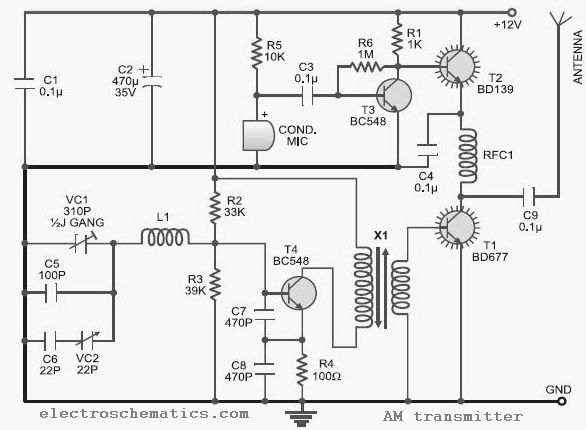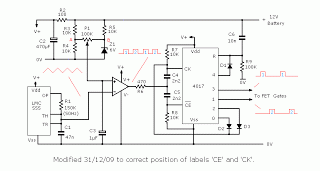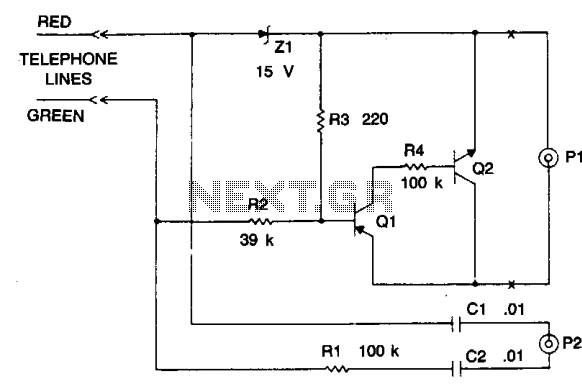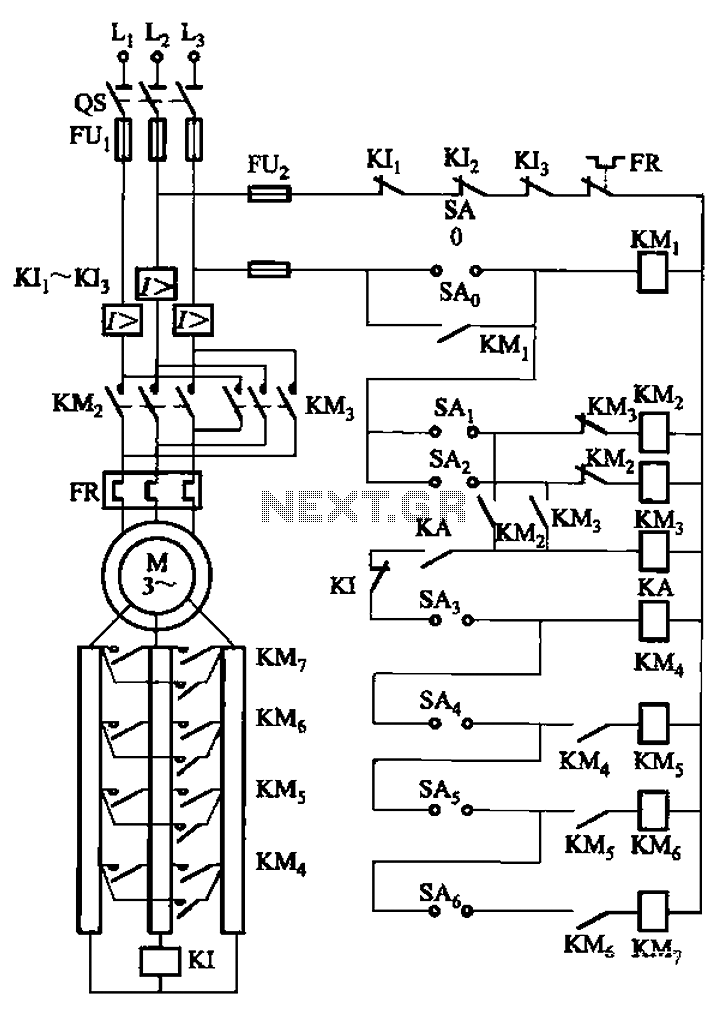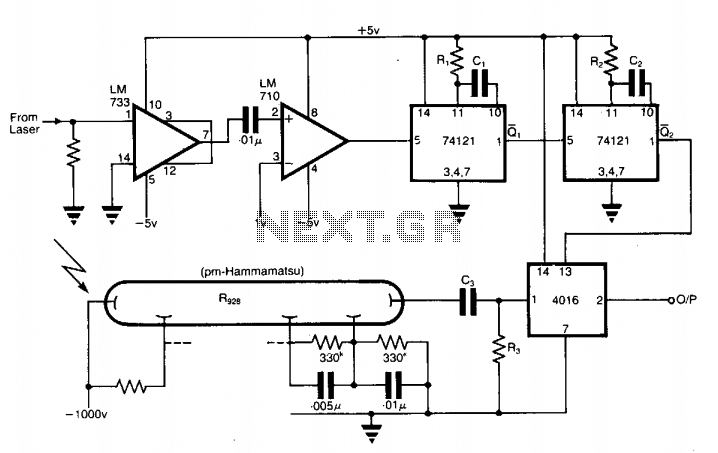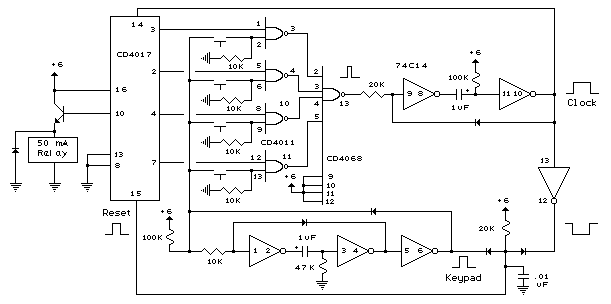
electronic timer with display circuit

The circuit is constructed using the ICM7217 integrated circuit from Intersil, which features a CMOS up/down counter with a four-digit display. The clock generator circuit, IC3, produces a square wave clock signal with a period of one second, available at pin 3 (Q13). This signal can be divided by 60 in IC4 for longer time measurements exceeding one hour. When switch S6 is closed, power is supplied, and IC1 is reset through resistor R9 and capacitor C5. The position of switch S4 determines whether minutes or seconds are counted, with the limits set to 59 hours and 59 minutes (position 2) or 59 minutes and 59 seconds (position 1). Miniature switches S10 and S7 are used to adjust the display to show 20.00. A brief press of switch S3 stores this selection in IC1. Subsequently, switches S7 to S10 are adjusted to set the display to 35.00, while switch S1 must remain open. Pressing switch S2 initiates the ICM7217C to start counting down from 35.00. When the display reaches 20.00, a buzzer emits a short sound.
The circuit employs the ICM7217, a versatile integrated circuit designed for digital timekeeping applications. The CMOS architecture allows for low power consumption and reliable operation. The four-digit display outputs the time in either minutes or seconds, depending on the configuration selected via switch S4.
The clock generator, IC3, is critical for providing a consistent timing reference, operating at a one-second interval. This clock signal can be further processed by IC4, which divides the frequency for applications that require longer time intervals, such as timing events that exceed one hour. The reset function is implemented through the combination of R9 and C5, ensuring that the circuit initializes correctly whenever power is applied.
The configuration of switches S7 to S10 allows for user interaction with the display, enabling the setting of countdown values. The ability to store and adjust these values enhances the circuit's functionality, making it suitable for various timing applications. The countdown feature is initiated by switch S2, which triggers the ICM7217C to decrement the displayed value. The buzzer serves as an alert mechanism, providing an audible signal when the countdown reaches the predetermined threshold of 20.00, thus signaling the completion of the timing cycle.
Overall, this circuit design showcases an efficient use of integrated circuits and user interface components to create a practical and user-friendly timing solution.The circuit is built using ICM7217 integrated circuit, manufactured by Intersil, which contains a CMOS counter up / down, with 4 digits and display properly. IC3 is the clock generator circuit which provides a square wave with period 1 s clock signal is available on pin 3 (Q13).
It can be divided by 60 in IC4, if necessary, measurement of longer t han one hour. When S6 is closed, power is connected and IC1 is reset by R9 and C5. S4`s position determine if minutes or seconds are counted: not exceeding 59 h and 59 min (position 2) or 59 min and 59 s (position 1). Miniature switches S10 S7 adjusts the display to indicate 20. 00. In a short press of S3, this choice is stored by IC1. After that, S7-S10 is adjusted so that the display to indicate 35. 00. Meanwhile, S1 must be open. Pressing S2 cause of integrative ICM7217C start counting backwards, starting from 35. 00. When the display shows 20. 00, buzzer sounds shorter. 🔗 External reference
The circuit employs the ICM7217, a versatile integrated circuit designed for digital timekeeping applications. The CMOS architecture allows for low power consumption and reliable operation. The four-digit display outputs the time in either minutes or seconds, depending on the configuration selected via switch S4.
The clock generator, IC3, is critical for providing a consistent timing reference, operating at a one-second interval. This clock signal can be further processed by IC4, which divides the frequency for applications that require longer time intervals, such as timing events that exceed one hour. The reset function is implemented through the combination of R9 and C5, ensuring that the circuit initializes correctly whenever power is applied.
The configuration of switches S7 to S10 allows for user interaction with the display, enabling the setting of countdown values. The ability to store and adjust these values enhances the circuit's functionality, making it suitable for various timing applications. The countdown feature is initiated by switch S2, which triggers the ICM7217C to decrement the displayed value. The buzzer serves as an alert mechanism, providing an audible signal when the countdown reaches the predetermined threshold of 20.00, thus signaling the completion of the timing cycle.
Overall, this circuit design showcases an efficient use of integrated circuits and user interface components to create a practical and user-friendly timing solution.The circuit is built using ICM7217 integrated circuit, manufactured by Intersil, which contains a CMOS counter up / down, with 4 digits and display properly. IC3 is the clock generator circuit which provides a square wave with period 1 s clock signal is available on pin 3 (Q13).
It can be divided by 60 in IC4, if necessary, measurement of longer t han one hour. When S6 is closed, power is connected and IC1 is reset by R9 and C5. S4`s position determine if minutes or seconds are counted: not exceeding 59 h and 59 min (position 2) or 59 min and 59 s (position 1). Miniature switches S10 S7 adjusts the display to indicate 20. 00. In a short press of S3, this choice is stored by IC1. After that, S7-S10 is adjusted so that the display to indicate 35. 00. Meanwhile, S1 must be open. Pressing S2 cause of integrative ICM7217C start counting backwards, starting from 35. 00. When the display shows 20. 00, buzzer sounds shorter. 🔗 External reference
